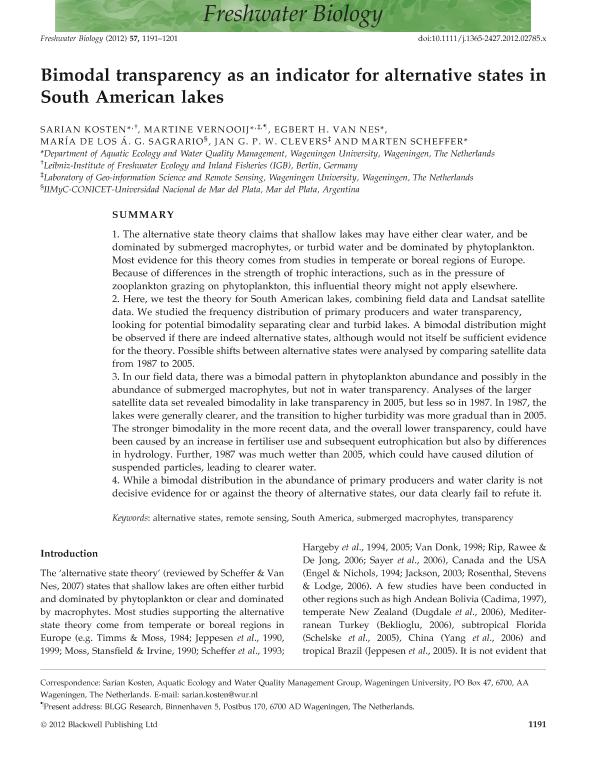Artículo
Bimodal transparency as an indicator for alternative states in South American lakes
Kosten, Sarian; Vernooij, Martine; Van Nes, Egbert H.; Gonzalez Sagrario, Maria de Los Angeles ; Clevers, Jan G.P.W.; Scheffer, Marten
; Clevers, Jan G.P.W.; Scheffer, Marten
 ; Clevers, Jan G.P.W.; Scheffer, Marten
; Clevers, Jan G.P.W.; Scheffer, Marten
Fecha de publicación:
06/2012
Editorial:
Wiley Blackwell Publishing, Inc
Revista:
Freshwater Biology (print)
ISSN:
0046-5070
Idioma:
Inglés
Tipo de recurso:
Artículo publicado
Clasificación temática:
Resumen
1.The alternative state theory claims that shallow lakes may have either clear water, and be dominated by submerged macrophytes, or turbid water and be dominated by phytoplankton. Most evidence for this theory comes from studies in temperate or boreal regions of Europe. Because of differences in the strength of trophic interactions, such as in the pressure of zooplankton grazing on phytoplankton, this influential theory might not apply elsewhere. 2.Here, we test the theory for South American lakes, combining field data and Landsat satellite data. We studied the frequency distribution of primary producers and water transparency, looking for potential bimodality separating clear and turbid lakes. A bimodal distribution might be observed if there are indeed alternative states, although would not itself be sufficient evidence for the theory. Possible shifts between alternative states were analysed by comparing satellite data from 1987 to 2005. 3.In our field data, there was a bimodal pattern in phytoplankton abundance and possibly in the abundance of submerged macrophytes, but not in water transparency. Analyses of the larger satellite data set revealed bimodality in lake transparency in 2005, but less so in 1987. In 1987, the lakes were generally clearer, and the transition to higher turbidity was more gradual than in 2005. The stronger bimodality in the more recent data, and the overall lower transparency, could have been caused by an increase in fertiliser use and subsequent eutrophication but also by differences in hydrology. Further, 1987 was much wetter than 2005, which could have caused dilution of suspended particles, leading to clearer water. 4.While a bimodal distribution in the abundance of primary producers and water clarity is not decisive evidence for or against the theory of alternative states, our data clearly fail to refute it. © 2012 Blackwell Publishing Ltd.
Archivos asociados
Licencia
Identificadores
Colecciones
Articulos(IIMYC)
Articulos de INSTITUTO DE INVESTIGACIONES MARINAS Y COSTERAS
Articulos de INSTITUTO DE INVESTIGACIONES MARINAS Y COSTERAS
Citación
Kosten, Sarian; Vernooij, Martine; Van Nes, Egbert H.; Gonzalez Sagrario, Maria de Los Angeles; Clevers, Jan G.P.W.; et al.; Bimodal transparency as an indicator for alternative states in South American lakes; Wiley Blackwell Publishing, Inc; Freshwater Biology (print); 57; 6; 6-2012; 1191-1201
Compartir
Altmétricas



